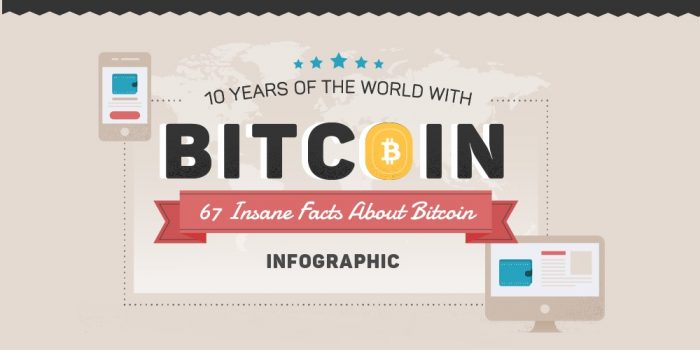
Despite currently trading around $8,000 and steadily increasing in popularity, cryptocurrencies are often still marred by fear and negative media coverage.
Bitcoin is transparent and digital, meaning when using it you don’t have to worry about counterfeit money. It’s the first successful use case of blockchain technology in digital payment. As Bitcoin’s introduction verges on its 10th year, it’s starting to gain further widespread adoption around the world. Here are 10 moments in its history that stand out as well as a bitcoin infographic with 67 insane facts.
Satoshi Nakamoto Launches Bitcoin with a Radical Agenda (January 2009)
You might assume that somebody who creates a new currency is probably in it for the money, and while Bitcoin’s mysterious founder Satoshi Nakamoto is estimated to own $4.7 billion worth of BTC, it’s the radical agenda behind the technology that has inspired many people to show their support.
“The Times 3 January 2009 Chancellor on brink of the second bailout for banks,” was the message Nakamoto left in the very first block that was mined that month – referencing an article about the financial crisis and the UK’s taxpayer-funded bank bailout.
Bitcoin is not controlled by any central government or authority, transactions are pseudonymous, and there are no inherent restrictions preventing any individual from using it as long as they are able to connect to the internet and use the web. Even in countries where BTC is outlawed, there isn’t always a realistic way to enforce the ban.
Without these radical elements, it could be argued that Bitcoin would not be as successful, as there wouldn’t be anything particularly unique about it.
Bitcoin Pizza Day (May 2010)
An example of BTC’s rise in value is “bitcoin pizza day,” the day which commemorates the very first consumer purchase using the currency.
On May 22, 2010, Laszlo Hanyecz bought pizza from 18-year old Jeremy Sturdivant, for 10,000 BTC, totaling approximately $25 at the time. Today this is worth over $50 million!
It wasn’t a direct transaction with the pizza place; rather Hanyecz sent the money to Sturdivant who agreed to place the orders.
Unfortunately, it is not known what Sturdivant did with his coins and if he’s now living the high life or kicking himself for spending them up before the boom in value. However, one person we do know who is kicking themselves is Hanyecz, who probably should have just made a sandwich and held on to his fortune.
Numerous independent and larger pizza chains now accept payment in BTC. Also, there are several online services that allow customers to pay a middleman in BTC, who will then order a desired service on your behalf in regular currency.
Europe Embraces Bitcoin (2011)
Although the US was its birthplace, Europe was quick to embrace Bitcoin. In 2011 French based exchange Bitcoin Central was the first exchange to be licensed under European regulation.
It subsequently assured customers’ balances up to 100,000 EUR and offered debit cards with access to BTC balances. In practice, this meant that Bitcoin (BTC) could be immediately exchanged into Euros at the point of sale or ATM.
In 2014, Belgium and Finland decided the cryptocurrency was exempt from VAT, meaning trades could be legally made without buyers being subject to tax.
In 2017, Swiss private bank Falcon became the first bank to sell bitcoin directly to its customers. The tradeoff is that anonymity is lost as transactions made by an account holder can be linked.
Time Magazine Article (April 2011)
It might not quite have the clout it used to, but Time Magazine featured Bitcoin in, giving it a rubber stamp of relevance among mainstream media.
This occurred in April 2011 with their piece entitled “Online Cash Bitcoin Could Challenge Governments, Banks.”
The article looked at the potential risks to users and barriers from governments, its use in the illegal dark web marketplaces, and its steep learning curve. Simultaneously it explored the benefits and then revolutionary concept behind the blockchain technology.
Since then, the magazine has done many more pieces (both positive and negative) on Bitcoin.
A Coupled Lived 90 Days on Just Bitcoins (Summer 2013)
Are bitcoins accessible to the average person? Do they work as a day-to-day means of exchange, or are they just for geeks, ideologues and investors?
Austin Craig and Beccy Bingham proved in the summer of 2013 that, yes, you can get by using only BTC. However, their 90 day experiment wasn’t easy – they could only use Skype to make calls, and purchases were dependent on whether they could convince retailers and service providers to accept the currency or use the kindness of friends and strangers to act as middle-men.
Of course, we’ve come a long way since then. Now even some gas stations are accepting BTC, and you can pay at many independent stores for groceries and other goods.
Cyprus University Accepts Bitcoins for Tuition (November 2013)
In an effort to ease transmission difficulties for certain students, the University of Nicosia in Cyprus began accepting BTC for student tuition in November 2013.
The private university’s CFO Dr. Christos Vlachos appears to be a proponent of the currency, stating: “Digital currency will create more efficient services and will serve as a mechanism for spreading financial services to under-banked regions of the world.”
In addition to being a practical move, he stated that it was a way for the institution to learn more about the technology firsthand.
A center of learning trying to learn something new? What a novel idea!
The Great Bitcoin Boom of 2013
2013 was a big year for bitcoin as it saw its value skyrocket from $125 in the September to over $1,100 by the end of November. This was heavily tied to the market’s expansion into populous China and a perfect storm of new media coverage and bullish investing.
Of course, rapid booms tend to preclude busts and the collapse of leading exchange Mt. Gox, a ban in China, numerous hackings, the closing of the illegal marketplace the Silk Road, and lots of negative coverage ensured this would be deep and painful (but not fatal).
Bitcoin’s value plummeted to $400 in April 2014 and hit lows of about $200 in January 2015.
Nonetheless, the community saw where Bitcoin could go and it would go higher still. Their optimism was confirmed with aplomb when BTC rose to almost $20,000 in value at the end of 2017.
Microsoft on Board (2014)
It’s one thing when an independent hipster coffee shop or an online tech store offer bitcoin as a payment method, but when a mega corporation like Microsoft gets behind something you know it has legs.
They began accepting BTC as a form of payment for digital items in December 2014, in partnership with BitPay – today’s leading Bitcoin payment service provider that launched in 2011 and was the first to offer a wallet on smartphones, making it much easier for the general public to get involved.
Microsoft also allows you to add money to your account with BTC via the ‘Redeem bitcoin’ feature.
Banks and Other Institutions Adopt the Technology (May 2015)
If you can’t beat them join them; this seems to be the perspective of governments, banks and other institutions that are now researching and investing in blockchain p2p technology themselves – a clear example of Bitcoin’s success.
In May 2015, NASDAQ adopted the blockchain to handle transactions. Then in September, Goldman Sachs, JPMorganChase, and Bank of America were among nine of the world’s biggest banks to join a pact to build the “fabric” of blockchain technology for the banking industry.
In March 2016, broker ICAP was the first to distribute data on trades to customers using blockchain, and in the May Santander became the first British bank to start using the tech for recording international payments.
In 2017, the US Government began investing in blockchain to protect healthcare companies from hackers, and by 2020 Dubai wants all government transactions to be blockchain-powered.
Despite all these entities owing their innovation to the founder of Bitcoin, the digital currency’s advocates are keen to point out that the technology was supposed to bypass the old guard, not empower it.
Mt. Gox Saga
The Mt. Gox saga is commonly considered a black mark on Bitcoin history. After all, in early 2014 there was a major scandal that saw the disappearance of approximately 850,000 bitcoins the exchange was holding in wallets and trades. By May 2016, creditors of Mt. Gox had claimed they lost $2.4 trillion because of the bankruptcy.
Yet, despite such a massive failure of the BTC market (at one time Mt. Gox was processing 80% of all currency trade related transactions), the cryptocurrency survived, rebounded and continues to thrive.
It was a much needed wake-up call for the community. Despite inherent encryption, entrusting third parties without security protocols to get it right was naïve. Now everybody knows better and the market is stronger because of it.
Bitcoin Explosion (2017)
2017 was the year of Bitcoin.
The cryptocurrency began the year valued just over $1,000 and finished it at nearly $20,000.
This massive increase in value saw it emerging from geeky-obscurity into the mainstream with force. This was the time to be a bitcoin trader. News channels, newspapers, sites that had never covered the topic before, all began blabbering about the new phenomenon, spewing controversial information and unchecked facts.
The surge of popularity led to many new investors joining, but also many got burned by the prodigal volatility of the cryptocurrency, which has more than halved in value since its zenith in late December 2017.
Bitcoin Today
As of the end of Mar 2018 bitcoin boasts over 24 million users (or digital wallets), nearly 2,400 ATMs in many countries, the number of daily transactions are growing exponentially, and it’s trading around $8,000. Bitcoin: success or failure? Check out these amazing facts about Bitcoin:








